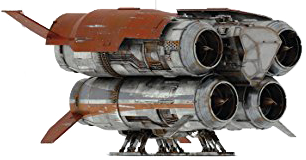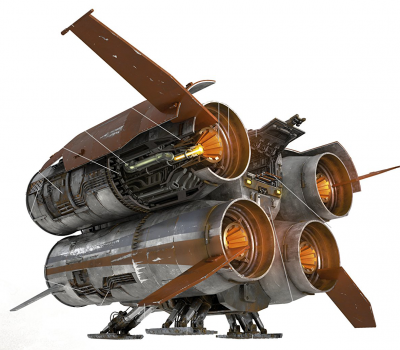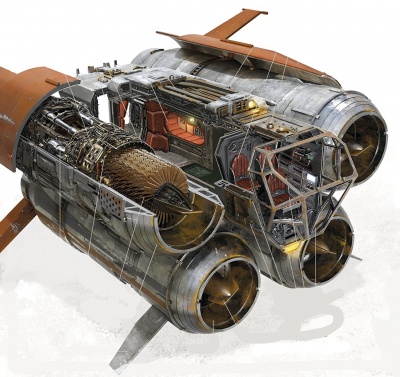Subpro Quadrijet Transfer Spacetug
Manufacturer
Subpro
Model
Quadrijet Transfer Spacetug
Class
Spacetug
Cost
? credits (New)
Max Space Speed
? MGLT
Hyperdrive rating
Class ?
Armament
None
Crew
1
Minimum crew
1
Passengers
2
Cargo capacity
? tons
Role(s)
Prospecting, Salvage, Smuggling
Background and History
The Quadrijet Transfer Spacetug, also known as the 'quadjumper', was a model of spacetug manufactured by Subpro for use in orbital transfer yards. The vessels used magnetic clamps to attach themselves to the undersides of cargo containers and then quickly move them around within the yards using their four large thrusters.
Design
The quadjumper was built around four cylindrical thrusters had engine intakes located at the front of the spacetug, with electrostatic baffle vanes that kept out dust. Behind these were a series of compressor blades, which made up the turbine engines used by the craft in atmospheric flight. At the rear of the thruster were the ion drives used for space flight, which kicked in once a series of thrust bypass doors opened as the craft left atmosphere. The vehicle lacked any standard armament, but could be easily modified with additions to the dorsal attachment points including weaponry, sensor packages, a tractor beam, or other components.
Above the vessel's cockpit, the spacetug had a tow cable housed underneath the rear hatch at the back of the ship. The bow cockpit was just large enough to hold three people, with an angular transparisteel bubble surrounding the cockpit with the pilot seat at the front. Two passenger seats were located behind the pilot's seat, and could be folded away in order to allow access between the cabin and the cockpit. A small cabin itself took up the central space between the four thrusters. It included at least one crew bunk built into the side walls and had hatches at either end leading to the cockpit at the front and the airlock exiting the ship at the back. A retractable cargo crane was hidden directly above the cabin on the roof of the ship. The magnetic clamps used to attach the vessel to freight containers were located above the cockpit of the tug


